by Steve Bi* (Advanced Biofuels USA) At one of a series of bioenergy conferences in Brussels, April 10-12, 2018, some combination of hearty guffaws, inward chuckles and solemn nods greeted the predictable but well-delivered punchline from Miguel Ivan Lacerda de Oliveiras of the Brazilian Ministry of Mines and Energy. “Do not... kill... the magic... plant!”
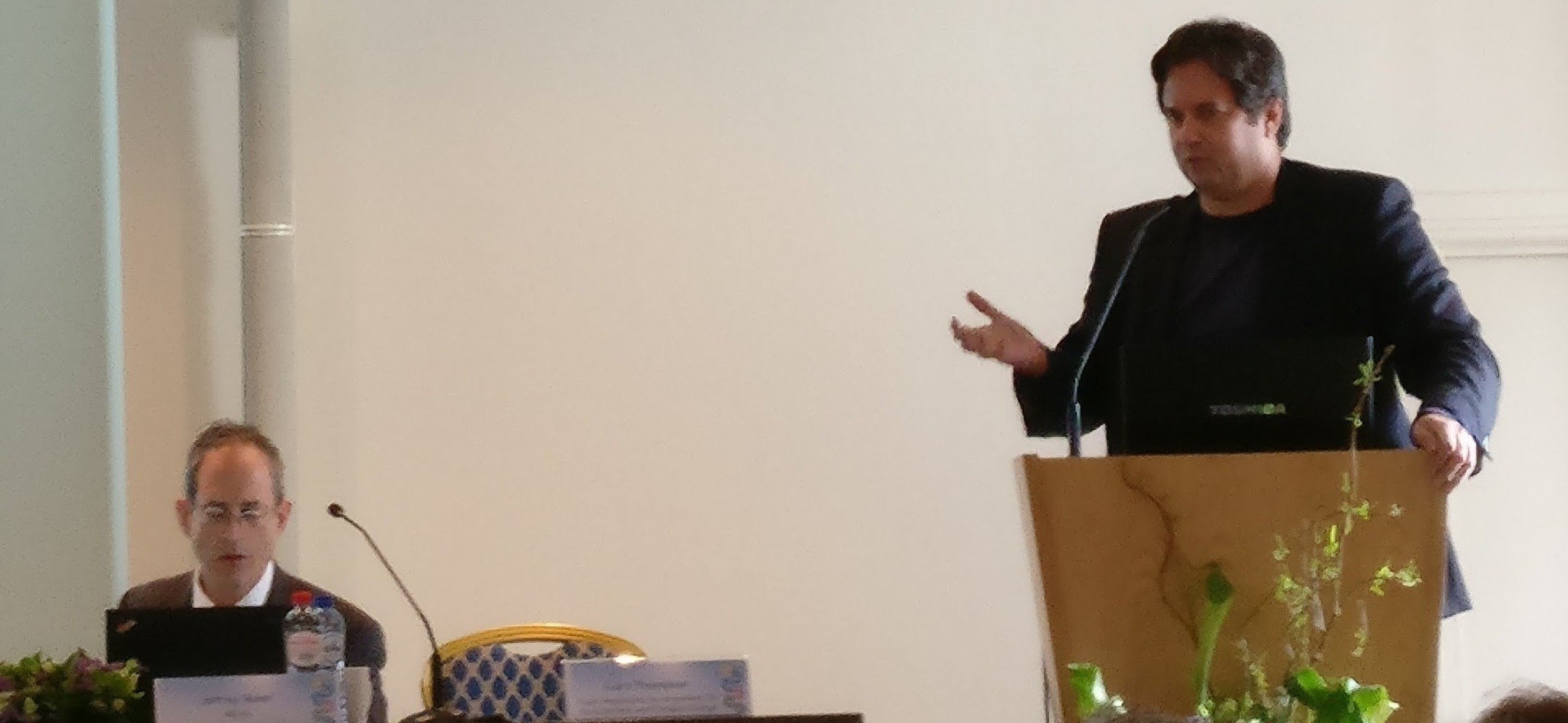 Miguel Ivan Lacerda de Oliveira from the Brazilian Ministry of Mines and Energy gives an impassioned presentation while Jeff Skeer, IRENA, moderates the session.
Miguel Ivan Lacerda de Oliveira from the Brazilian Ministry of Mines and Energy gives an impassioned presentation while Jeff Skeer, IRENA, moderates the session.
The Fable of the Magic Plant
The “magic plant” in his fairy tale – or magic plants, or trees, or seaweed, or magic waste, for that matter – represents, in the hypothetical world where bioenergy policy appears to be forever trapped (more on that later), the future discovery of a wonderful organism which can be efficiently converted to any and all forms of final energy at highly competitive prices.
In Lacerda’s telling (or an extended facsimile thereof), a rural farmer – somewhere around the Amazon basin – happens to notice one day a new weed spreading like wildfire around the perimeter of his cropland. Not only this, but his sugarcane crops in direct contact with the weed have grown twice as high as the rest of the field.
The intellectually curious man that he is, he decides to harvest some of this alien shrubbery as best as he can, supplying some to his business partner, the local bio-processing and biofuel production plant, while transplanting the rest across certain sections of his plantation. To their pleasant bewilderment, one tonne of pre-processed (wet) feedstock could produce twice the ethanol or triple the renewable diesel as a tonne of dried sugarcane, and the intercropped segments of his farm were ready for harvest twice as quickly as his monocultured fields!
The business partners introduced their magic plant to biofuel facilities all across Brazil, and within a year the domestic biofuel production tripled. The price per liter was already approaching that of sugarcane-based fuels and projected to undercut petrol prices within five years. Cradle-to-grave life cycle assessments (LCA) consistently reported net negative greenhouse gas (GHG) emissions and minimal environmental impacts.
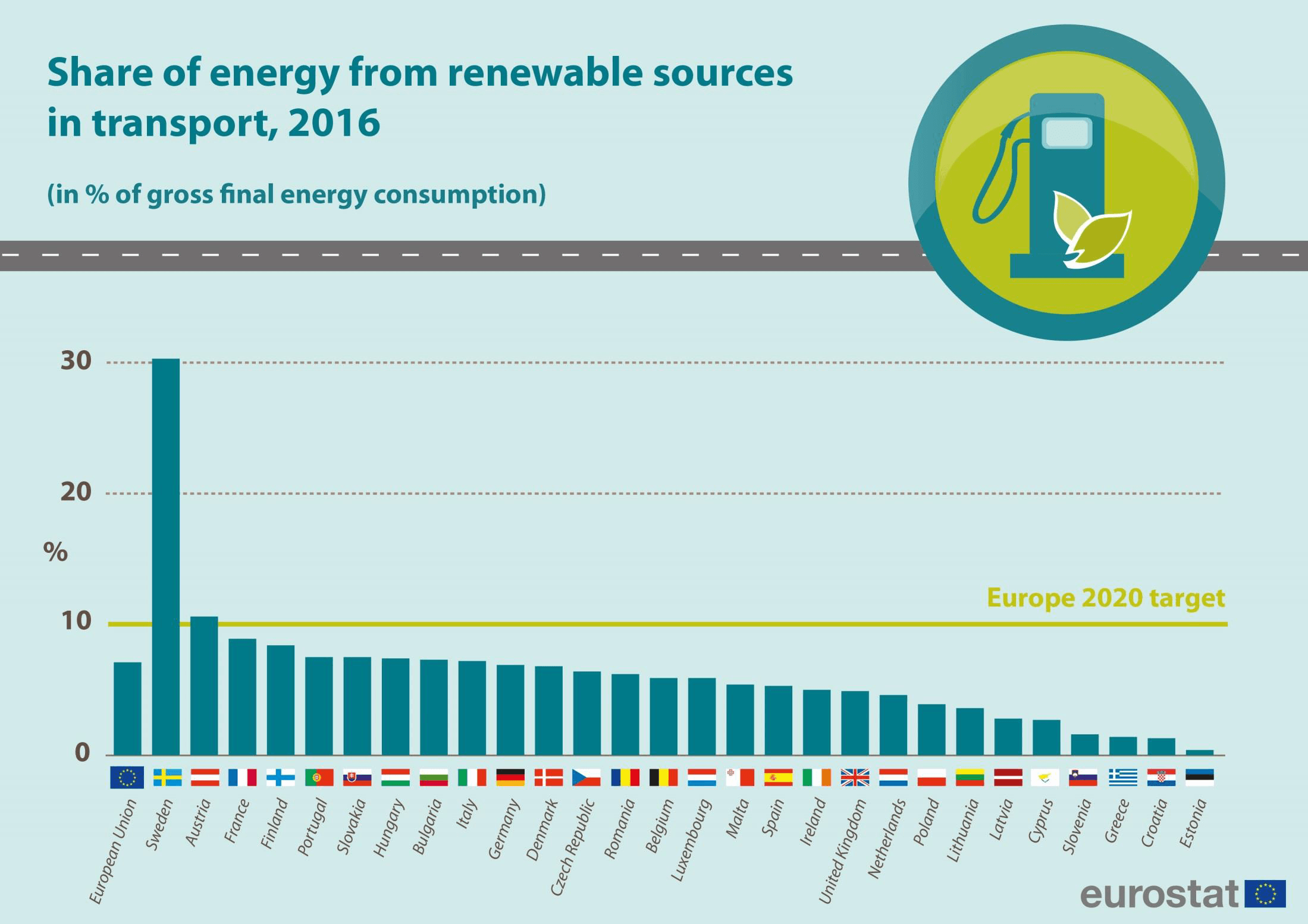 This graphic prepared by Eurostat and presented by Giulio Volpi of the EC's Directorate-General for Energy (DG ENER) shows the shortcomings of the RED in spurring biofuels growth.
This graphic prepared by Eurostat and presented by Giulio Volpi of the EC's Directorate-General for Energy (DG ENER) shows the shortcomings of the RED in spurring biofuels growth.
The Journey of the Magic Plant
The country’s largest biofuels producer could hardly contain its excitement as it commenced negotiations with EU partners to export both the surplus fuels on hand and the magic seeds of this most incredible plant.
“I’m sorry, but what in the world is this thing?” came the collective reply from the EU biofuels industry. “I don’t see ‘magic plant’ listed here in Annex IX of RED II”, referencing the updated Renewable Energy Directive which European Union (EU) legislators are aiming to finalize by the summer of 2018, one of the primary reasons for this spate of bioenergy conferences in the European Commission’s backyard.
Annex IX of this law specifies lists of “advanced” feedstocks eligible for double-counting toward the EU’s targets for renewable energy in transport by 2030, a topic of heated contention at the week’s first conference co-hosted by the Commission, the Food and Agriculture Organization (FAO), the International Renewable Energy Agency (IRENA) and the BioFuture Platform, titled “The role of low carbon fuels in decarbonising transport: the emerging consensus from international initiatives.”
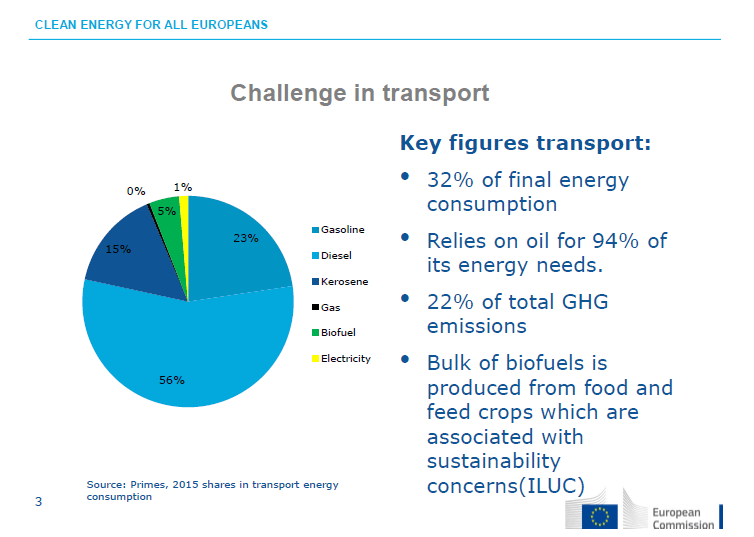 This slide from DG ENER highlights the monopoly enjoyed by oil in the EU transport fuels market. And yet, the Commission has diverted its attention to the uncertain risk of ILUC from biofuel production (while ignoring any ILUC effects of oil production and spills).
This slide from DG ENER highlights the monopoly enjoyed by oil in the EU transport fuels market. And yet, the Commission has diverted its attention to the uncertain risk of ILUC from biofuel production (while ignoring any ILUC effects of oil production and spills).
The EU bioenergy producers thus concluded that magic plant fuels would not be a worthwhile investment since they would not even single-count toward the RED target, as the 7% limit on “conventional” biofuels had already been reached, and thus there would be no possibility of public funding for their endeavors.
Slightly discouraged, the Brazilians then took their magic plant to the European Commission (EC), convinced that they simply needed to pass an amendment to Annex IV.
The Commission deliberated, “From what we understand, this magic plant grows best on cropland and in the rainforest, correct? Certainly the ILUC factors will be intolerable!”
Indirect land-use change (ILUC), has taken the biofuels policy debate by storm, and nowhere so intensely as in the EU. A play-by-play of the topic’s representation at the conferences can be found in the second installment of this feature, to be published next week, detailing numerous challenges to the EU’s position.
Still intrigued nonetheless, the EC decided to finance a three-year study on the magic plant’s ILUC and biodiversity impacts. An equivalent investment would have sufficed to reclaim land for magic plant farming, to train farmers on intercropping techniques, and to retrofit dozens of bioprocessing plants for optimal efficiency, but the EU is determined to only provide support for unequivocally sustainable technologies.
The Fulfillment of the Promise of the Magic Plant
Three years later, the verdict was finally in. A variety of studies using a variety of models which rely on a variety of assumptions had come to a variety of conclusions.
This uncertainty, theoretical and subjective though it may be, is considered cause enough for concern by the EC that the 2029 draft proposal for RED III would stipulate that the magic plant - despite its most magical properties arising when intercropped - shall only count toward 2040 targets if grown on marginal or reclaimed land.
And just like that, the EU killed the magic plant. While yield-doubling intercropping became the norm across Brazil and existing co-located infrastructure was leveraged to drastically mitigate capital expenditure, stranded assets and transport costs, the magic plant struggled to attract a single Euro of investment across the pond, and fossil fuels would continue to dominate the EU transport sector as policymakers patiently await full electrification.
The bioeconomy boomed across South America, and country after country surpassed their Paris Accord NDC’s (nationally determined contributions), but the globally coordinated effort and massive bioenergy scale-up necessary to achieve the 2oC target was hardly any closer to becoming a reality.
An especially formidable reason for this is that an eerily similar story can be imagined for the magic plant’s experience in the US, where every individual pathway for renewable fuel production must be explicitly approved for admittance to the Renewable Identification Number (RIN) system of the Renewable Fuel Standard (RFS), a process which takes an average of 2.9 years on the most recent accounting.
The Moral of the Story
The overarching moral of the story is that we must be wary when crafting policies both supporting and regulating bioenergy such that they don’t result in the lock-out of new technologies from the market.
(I’ll take this opportunity for some shameless self-promotion, as a more detailed analysis of the lock-out effect in the transportation sector (relying on historical and modern realities rather than future fantasies) was the topic of my Master’s thesis, and a succinct write-up by Michael Eggleston can be found here.)
The magic plant is of course an exaggerated amalgamation of the most desirable qualities of a bioenergy feedstock, but Lacerda’s story was not simply a mood-lightening, attention-grabbing rant. Instead, the trials of the magic plant are rooted in reality, and this elegantly crafted tale captured just about every major topic on the conference agenda.
Unfortunately, the wide-ranging reasons for the ultimate lock-out of the magic plant also describe the current lock-out forces facing established biofuel technologies today.
 Renato Godinho, interim facilitator of the BioFuture Platform (right), gives his presentation as Kyriakos Maniatis, Principal Administrator of New Energy Technologies Innovation & Clean Coal at DG ENER and the coordinator of the conference (left), looks on.
Renato Godinho, interim facilitator of the BioFuture Platform (right), gives his presentation as Kyriakos Maniatis, Principal Administrator of New Energy Technologies Innovation & Clean Coal at DG ENER and the coordinator of the conference (left), looks on.
The Emerging Consensus from International Initiatives
Fellow Brazilian Renato Godinho, the Head of Renewable Energy of the nation’s Ministry of Foreign Affairs, concisely highlighted the five consensuses emerging from international research and industrial cooperations.
Also serving as the interim facilitator of the BioFuture Platform, an international cooperation between 20 nations leading the bioenergy charge (technically 19 at the moment as the US has delayed ratification) conceived at COP22 Marrakech with the mission to “accelerate the transition to an advanced, low carbon, global bioeconomy,” Godinho is certainly well-qualified to make such a claim.
These five items are listed and discussed below; two will be analyzed in this article and three in a continuation next week.
Consensus #1: Whether we like it or not, bioenergy must be massively scaled up.
During his presentation, Godinho posed the ultimate existential question: Sustainable bioenergy acceleration needs to happen, and we need to make it happen, fast… but can we?”
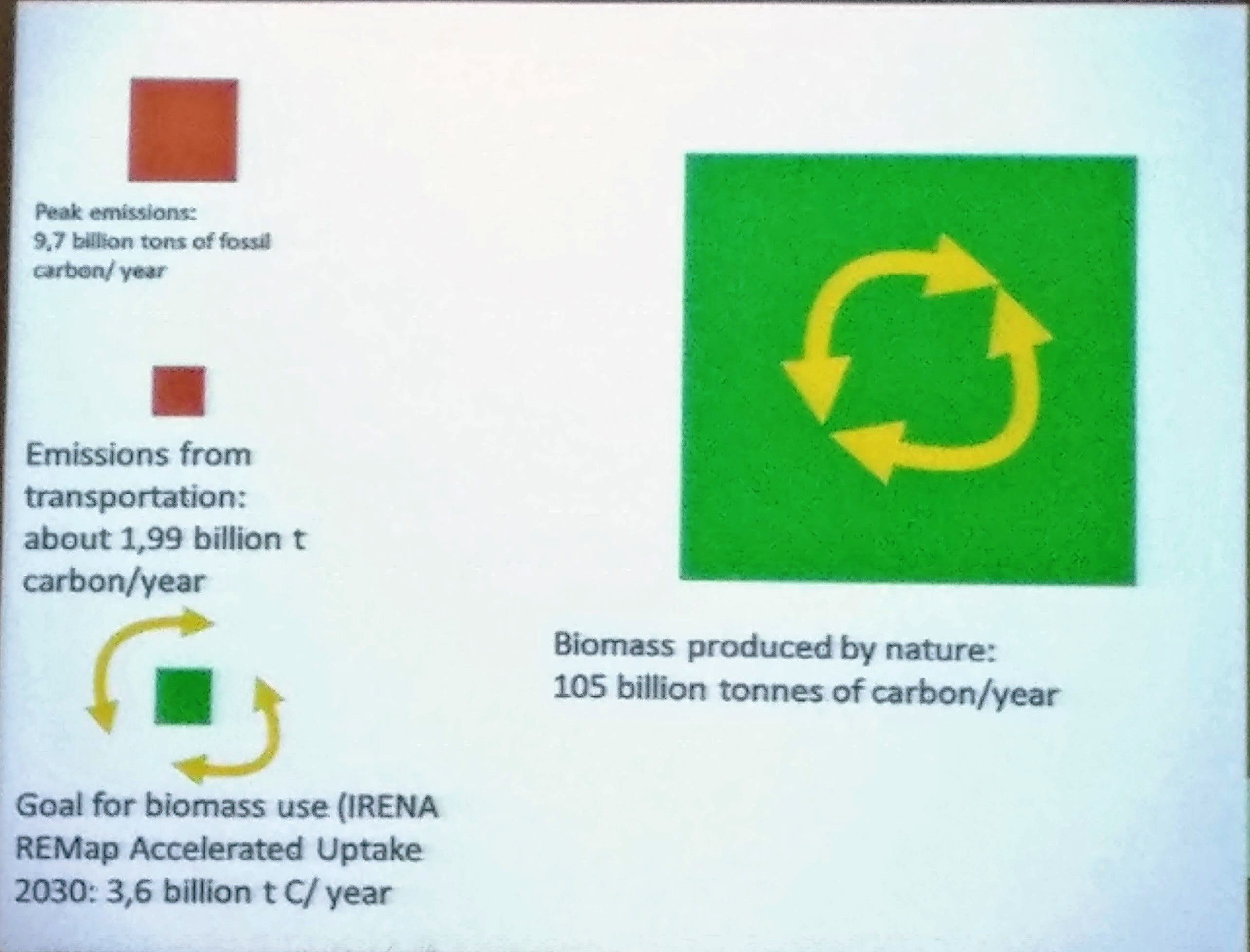 BioFuture Platform's acting coordinator Renato Godinho's simple and elucidating graphic on the question of biomass availability and requirements.
BioFuture Platform's acting coordinator Renato Godinho's simple and elucidating graphic on the question of biomass availability and requirements.
He started his answer his own question with a simple yet powerful graphic. Each year, nature produces 105 billion tonnes of carbon. This is a mammoth figure compared to the annual emissions from transportation (1.99 billion tC/yr) and the 2030 goal for biomass use of (3.6 billion tC/yr) set by IRENA.
Of course it’s only a certain percentage of that naturally renewed biomass which is available for use, but seeing as we are only proposing to tap into a miniscule portion (3.6 billion tonnes out of the 1.26 trillion tonnes produced over the next 12 years), we can stop wasting time and money now on studying biomass availability.
The final conclusion was that, with the right measures, of course we are capable of scaling up bioenergy to the necessary volume.
IRENA’s Director of Innovation and Technology, Dolf Gielen, and Senior Programme Officer for Technical Cooperation, Jeff Skeer, later presented their study published the week following the conference (April 18) and alluded to above, which asserts that biomass is the most important source of renewable energy in the world.
The main finding was that renewable energy accounts for 90% of the worldwide defossilization potential by 2050, and biofuels represent 37.5% of the cost-effective RE potential in 2050 across the globe.
Within Europe, a whopping 50% of the cost-effective RE potential by 2030 is bio-based, as biofuels should command 33% of the transport fuels market. Reiterating Godinho’s point, these figures are well within physical reach because, by their estimates, the global supply potential of sustainable biomass is 500 EJ while the 2050 target requires just 87 EJ.
Volumetrically speaking, this translates to 900 million liters of biofuel in the global energy supply by 2050 - about 450 million liters each from conventional and advanced feedstocks by their projections - meaning a six-fold increase over today’s supply. To achieve this volume, the biofuel industry must see a five-fold acceleration in annual growth, the sooner the better of course.
The level of ambition in biofuel policies in major economies such as the EU and the US has been heading the opposite direction recently, however, and Gielen’s response to these policymakers is, “If you don’t do biofuels, then please tell me: ‘What is the alternative to meet climate objectives?’”
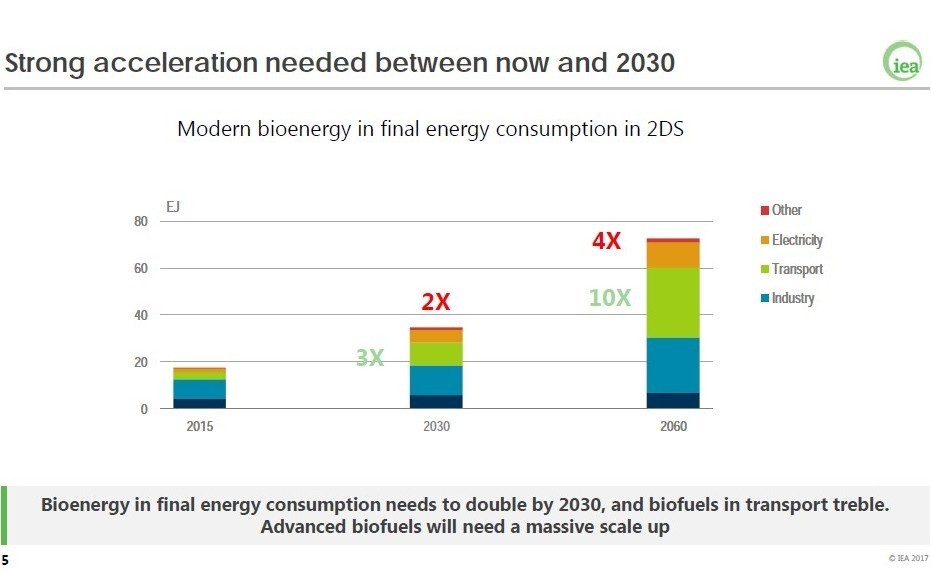 Dr. Paolo Frankl of the IEA presented the large increase in bioenergy necessary by both 2030 and 2060 according to the IEA Bioenergy Roadmap 2017.
Dr. Paolo Frankl of the IEA presented the large increase in bioenergy necessary by both 2030 and 2060 according to the IEA Bioenergy Roadmap 2017.
Dr. Paolo Frankl, Head of the Renewable Energy Division of the International Energy Association (IEA), was prepared with an answer to this question during his presentation: “There do not exist any decarbonization scenarios without a massive contribution from bioenergy.”
The IEA released a sister publication to the IRENA study on the same date which arrived at very similar metrics, in particular that RES represents 75% of the global decarbonization potential by 2050, and that biofuels account for about 30% of that total.
The 15% gap between the two agencies’ reports is due to the IEA’s projection of a more rapid uptake of carbon capture technologies. However, the bottom line is clear, he explained: we are going to need a lot of renewable energy, and fast.
Frankl echoed IRENA’s innovation director’s call for at least a 5-fold increase in annual biofuels growth rate, and added that advanced biofuels, for all the political hype around them, will need to shift into overdrive with a 10-50x growth rate acceleration, depending on when exactly we begin to see this trend.
At the second conference of the week, the Eighth Stakeholder Plenary Meeting (SPM8) of the European Technology and Innovation Platform (ETIP, a reference forum on bioenergy for the EC’s Directorate-General for Research and Innovation), Frankl’s IEA colleague Dr. Adam Brown further added that the global transport sector needs a 3-fold increase in biofuels by 2030 to remain on pace for the 2-degree scenario (2DS).
It is important to note, in my opinion, that the IEA’s 2DS actually only represents a 50% probability of staying below 2oC warming by 2100, meaning that an even greater and faster scale-up will be necessary to give ourselves a better chance at climate goals than a coin flip.
The hard numbers and the IEA’s proposals for how to achieve them can be found in the IEA Bioenergy Roadmap 2017, which to their credit also includes a “beyond 2o scenario” (B2DS).
In the face of these daunting challenges, both Frankl and Brown offered some words of encouragement.
In terms of how such a massive market movement might look, Frankl - along with several other speakers at the conferences - offered that advanced biofuels ought to attempt to replicate the success of solar PV.
In Germany, the price-per-watt of solar power has decreased by 90% since feed-in tariffs were implemented in 2004, exalted Dr. Hermann Pengg, Audi’s Head of Project Management in e-fuels. Political and social will are prerequisites for such a rapid transition, but well-designed legislation can and will stimulate the necessary investments and action.
For his part, Brown presented an outside-the-box metric showing that the buy-down cost of all the advanced biofuel plants we will need for the IEA’s 2050 target amounts to *just* $100 billion, a measly 0.5% of the $200 trillion that the world happily spends every year on fossil fuels today.
Thus, the issue with biofuels for investors isn’t the cost, but rather the associated risk, largely stemming from regulatory uncertainty and sensationalized public debate.
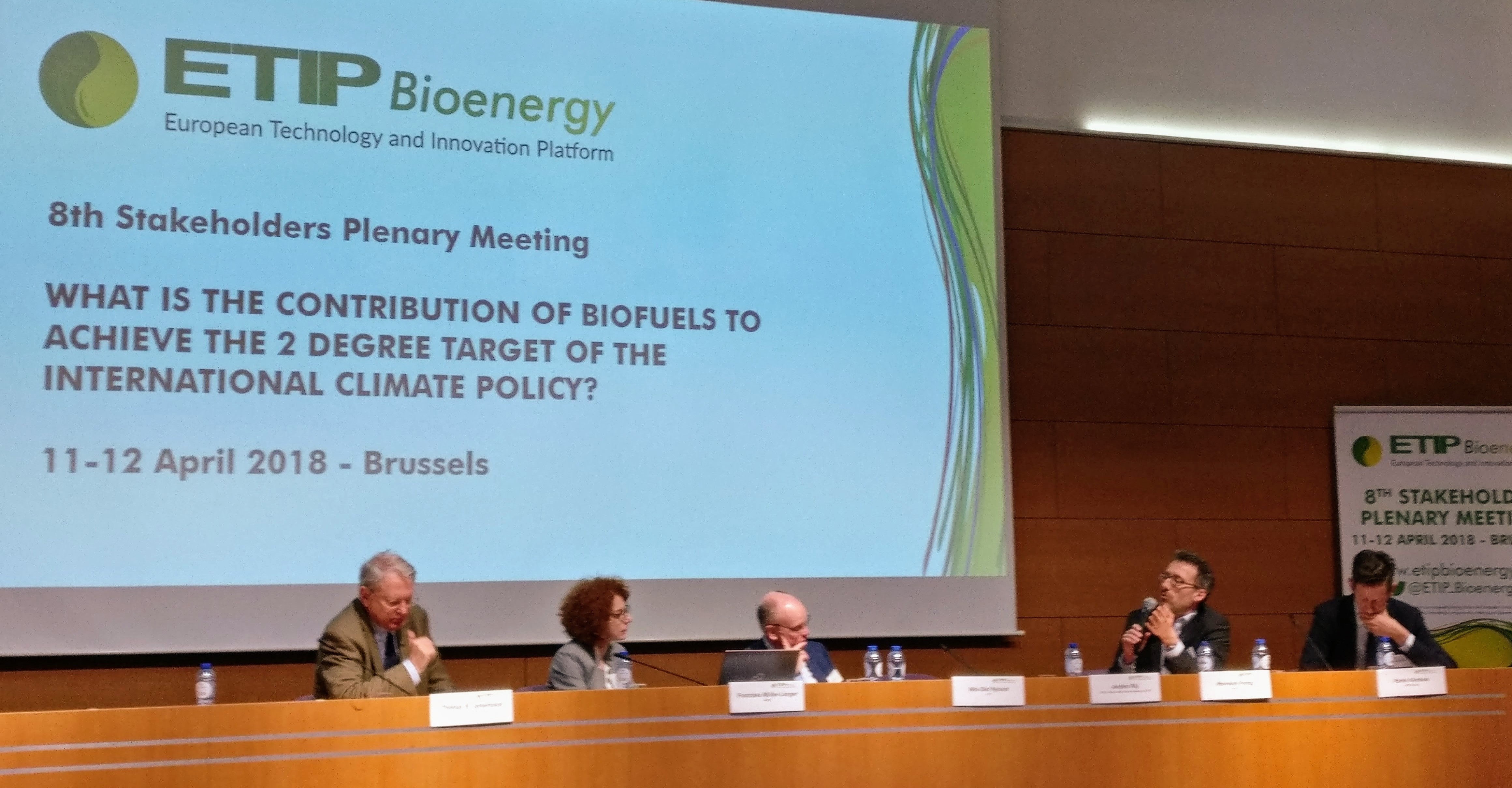 ETIP Bioenergy Platform Chair Patrick Klintbom (far right) moderates a panel discussion between Hermann Pengg of Audi (second from right), Nils-Olof Nylund of VTT (third from right), Franziska Mueller-Langer of the German Biomass Research Center DBFZ (second from left), and keynote speaker Thomas B. Johansson of Lund University (far left).
ETIP Bioenergy Platform Chair Patrick Klintbom (far right) moderates a panel discussion between Hermann Pengg of Audi (second from right), Nils-Olof Nylund of VTT (third from right), Franziska Mueller-Langer of the German Biomass Research Center DBFZ (second from left), and keynote speaker Thomas B. Johansson of Lund University (far left).
Consensus #2: Divisions in the bioenergy debate are being healed by advancing knowledge.
“In the 2000s, biofuel associations were constantly fighting amongst themselves.”
If anyone should know this, it’s Dr. Kyriakos Maniatis, a Principal Administrator at DG Energy who has been managing biofuels demonstration projects for over 20 years. He was also the coordinator of the week’s kick-off conference, which he closed by posing the question, “Why are first generation and second generation biofuels still fighting?”
This voiced the predominant sentiment among conference attendees, not the least of whom included magic plant advocate Miguel Ivan Lacerda in his assertion that the categorization between 1g and 2g biofuels is detrimental and arbitrary.
He was also the first to place a label on this political debate, one of many offered throughout the conference - “religion vs. rationality.”
Though perhaps unnecessarily abrasive and alienating toward the billions of people of faith around the world - better proposals for the wording of this concept, which became widely adopted by the conference’s second day, include “dogmatic vs. agnostic” and “simple vs. complex” - his point is well taken in context.
If your religion is to value sustainability above all, then please, by all means, practice and preach. Unfortunately, misinterpretations can sometimes dominate and define a religion.
Such is the case in the biofuels realm, where, according to Frankl of the IEA, these fanatics (or vested interests) have driven “polarized debate based on myths & fake news rather than facts.”
There is no rationale, as far as the climate is concerned, for discriminating against biofuels for any reason other than emissions reductions.
A feedstock doesn’t produce better ethanol, more money, or greater energy security simply because it’s newer and uses “advanced” conversion technologies. Even the magic plant didn’t purport to produce a higher quality fuel; its biophysical properties just happen to allow it to produce a higher quantity more efficiently.
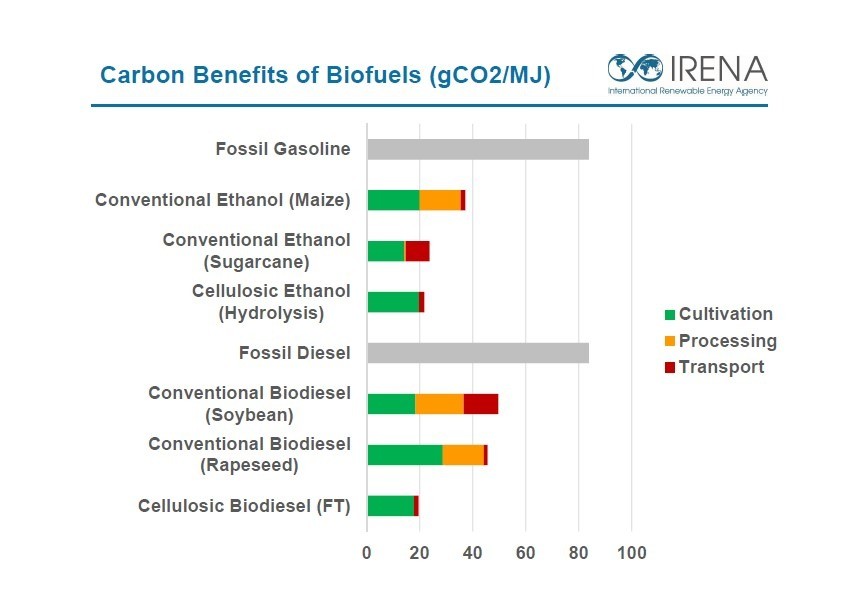 Jeff Skeer of IRENA presented this slide comparing the LCA CO2 emissions across different transport fuels.
Jeff Skeer of IRENA presented this slide comparing the LCA CO2 emissions across different transport fuels.
To this day, however, no feedstock has yet to be proven - in practice, that is - to be more efficient and sustainable than sugarcane, a “first-generation, conventional, food-based” crop.
And yet, these labels have spread a religious doctrine against this environmentally and socioeconomically friendly agricultural product to the point where the EU originally proposed to phase it out altogether as part of RED II.
Now in the final trilogue of negotiations between the EC, the Council of the EU (Council), and the European Parliament (EP), the law-to-be is all-but-settled instead on a 7% cap on the share of “food-based” biofuels in the transport energy mix by 2030.
Every EC representative in attendance at the week’s string of gatherings - barring Maniatis of DG Energy - was eager to point out that this regulatory limit doesn’t explicitly discourage fuel producers or member states from pursuing far greater volumes of 1g biofuels, and that the EU’s stance is simply to provide targeted support for those technologies which are unequivocally sustainable (i.e. Annex IV-listed biomass).
Godinho was one to openly criticize this EU position, stating that we don’t have the luxury anymore to forego any marginal reduction of GHG emissions.
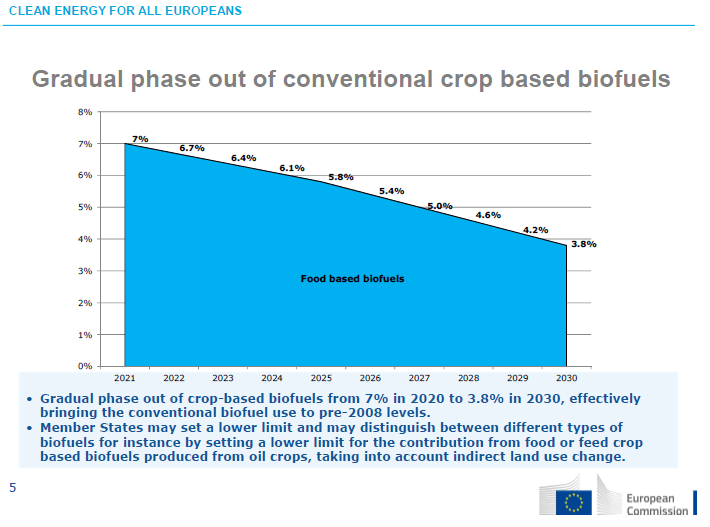 Bernd Kuepker of DG ENERGY presented this slide depicting the EC's proposal to gradually phase out 1g biofuels. This was fortunately rejected in favor of placing a 7% cap on such fuels.
Bernd Kuepker of DG ENERGY presented this slide depicting the EC's proposal to gradually phase out 1g biofuels. This was fortunately rejected in favor of placing a 7% cap on such fuels.
He was far from alone, as the IEA’s Brown responded to the notion that the EU promotes quality over quantity by quipping, “In Europe I don’t think there is much competition between quality and quantity because we don’t have much of either.”
The irony of the EU, as illustrated by the magic plant example, is that the RED’s list-based approach only reinforces the dogmatism surrounding “EU-quality” fuels and can facilitate the lock-out of the next-generation feedstocks, let alone the currently market-ready options.
Or, the opposite future is also conceivable, in which the magic feedstocks of tomorrow are so promising that Annex IX is completely overhauled in their favor, once again cutting off the “old news” technologies from funding.
It’s hard to imagine, however, that the EC hasn’t received an earful from investors, whose worst nightmares consist of politically-planned booms interrupted by politically-forced busts.
On that topic, Lacerda provided the room with another bittersweet laugh. “If you walked into a bank today and asked for a loan for a biofuels plant, they wouldn’t even offer you a coffee.”
While the investment quagmire may be the single greatest barrier to bioeconomy scale-up, and while it is certainly a symptom of this regulatory uncertainty, the primary cause of the legislative walk-backs was the classic bioenergy debate of “fuel vs. food” and its effect on public perception.
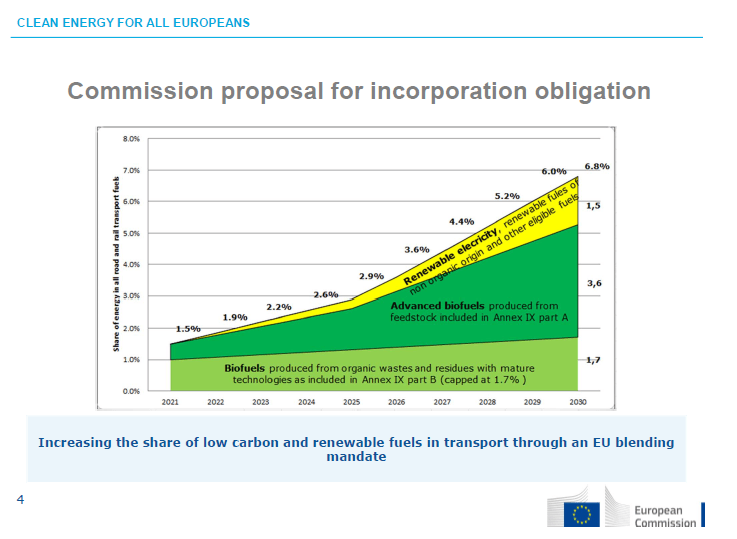 This slide from DG ENERGY shows their projections for growth through 2030 of "advanced" biofuels from feedstocks listed in Annex IX of RED I
This slide from DG ENERGY shows their projections for growth through 2030 of "advanced" biofuels from feedstocks listed in Annex IX of RED I
This is a debate that all representatives of international organizations were ready to quash, and which only the EU legislators in attendance still appeared to dwell on.
Brown, for one, instigated that there is “no such thing as ‘food-based biofuels,’” because the competition at the end of the day is over land use, not food supply.
An even more powerful condemnation of this overblown topic was the fact that Olivier Dubois, Senior Natural Resources Officer and Coordinator of the Energy Programme at FAO - the FOOD and Agriculture Organization - could be seen leading the charge against the EU’s war on conventional biofuels.
These food crops under such heavy scrutiny are actually “flex crops,” as he terms them, which empower farmers, communities, biorefineries, investors, governments, and society at large to decide how to best utilize them at any given time.
“Food and fuel, not food vs. fuel,” is where the EU should really be taking this impassioned dialogue, Dubois exclaimed.
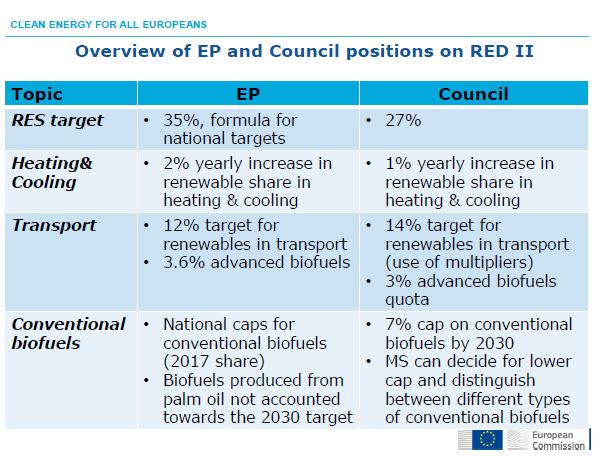 The current state of RED II negotiations between the EC, the EP and the Council. The lack of ambition in the transport sector was frequently pointed out by conference attendees.
The current state of RED II negotiations between the EC, the EP and the Council. The lack of ambition in the transport sector was frequently pointed out by conference attendees.
Now, I hesitate to call the food vs. fuel debate the root cause of the issue because its genesis can in turn be traced back, according to some, to a joint misinformation campaign by (surprise) the American Petroleum Institute (API) and the Grocery Manufacturers Association (GMA).
A proper investigation into the validity of this claim and similar ones to illuminate the sponsors behind each of the other debates that have carved dividing lines within and around the biofuels industry are obvious next steps if we hope to ever put these debates to rest, in my opinion.
Though not directly in reference to these sensationalized anti-biofuels talking points, this cry for us to remain vigilant against the flow of “dark money” was the closing argument of the keynote speech at ETIP SPM8 given by Prof. Dr. Thomas Johansson of the International Institute for Industrial Environmental Economics.
Factual, tangible, relatable and ultimately shareable evidence against the powers acting discreetly against the public interest must be widely disseminated to combat the ever-expanding phenomenon of fake news propaganda.
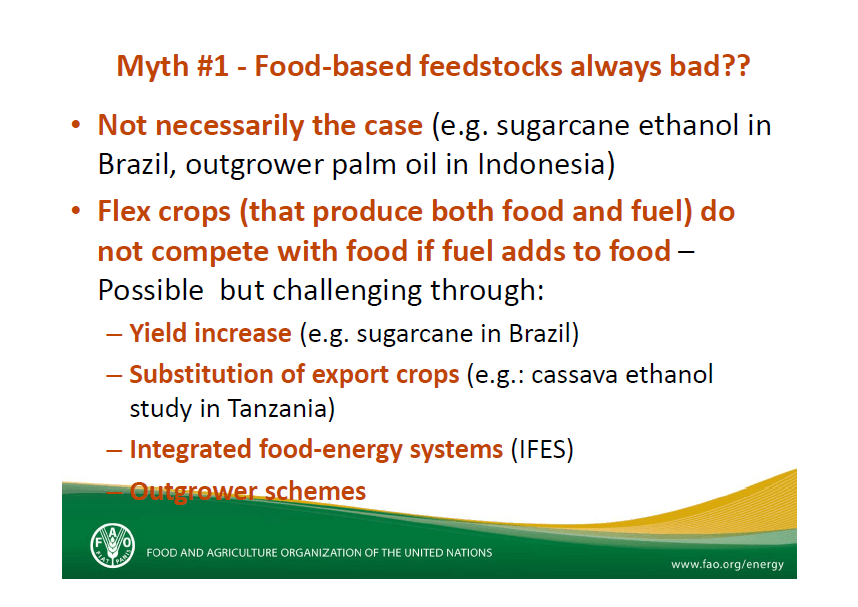 Olivier Dubois of the FAO led off his presentation by dispelling some commonly propagated myths surrounding biofuels. The first myth was also the foremost.
Olivier Dubois of the FAO led off his presentation by dispelling some commonly propagated myths surrounding biofuels. The first myth was also the foremost.
While it is certainly encouraging that opinions and research within the international biofuels community is converging on positive, rational consensuses, we must remember that this is but the first step toward realizing the goal of developing an environmentally and economically critical bioeconomy.
Olivier Dubois, who’s had his share of first-hand experience in pitching biofuels projects, lamented the fact that giant multinational banks would often simply stop listening if he gave the “incorrect” response to their question, “Will this produce first generation or advanced biofuels?”
He proposes that next year, when the EC and international organizations round us all up again, we make sure to personally deliver a cordial invitation to the European Investment Bank, the World Bank and other major financial institutions.
With legislation leaning the wrong direction, these investment firms have the power to supersede political will rather than to simply follow it.
Maniatis, conference coordinator and member of the EC, added further that there was a glaring absence of any representation from the EP at these lively discussions. It will have to suffice for this year to send a rapporteur their way with the main takeaways.
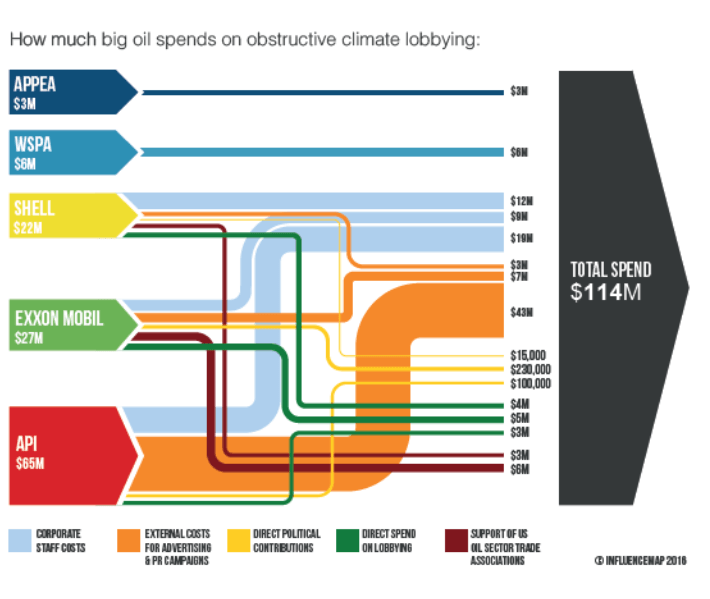 London-based research group InfluenceMap "followed the money" to produce a 2016 study on the political expenditure of just 5 major oil interests and just how that dark money is spent. Their rough estimate of the total annual budget devoted to obstructive climate lobbying worldwide was "in excess of $500 million", and this likely does not include SuperPAC contributions in the US. In contrast, they estimate that pro-climate policy lobbyists spend less than $5 million per year.
London-based research group InfluenceMap "followed the money" to produce a 2016 study on the political expenditure of just 5 major oil interests and just how that dark money is spent. Their rough estimate of the total annual budget devoted to obstructive climate lobbying worldwide was "in excess of $500 million", and this likely does not include SuperPAC contributions in the US. In contrast, they estimate that pro-climate policy lobbyists spend less than $5 million per year.
He then turned his attention away from the Parliament and toward his fellow EC members. It certainly was interesting, he remarked, “that the Commission representatives didn’t stay for any discussions [after delivering their presentations].” It sends a clear and unbecoming message that the EC is now closed off from stakeholders after their position - printed in the RED II draft proposal - is fixed.
Fittingly, not a single EC member was in the audience to hear these closing remarks from the nearly 30-year veteran of the Commission.
A representative of the French company Global Bioenergies summed this unfortunate reality up with a pointed comment from the floor: “I’m concerned that the convinced are busy trying to convince the convinced.”
Let this be an adage for us all. Please don’t hesitate to share this article or any other science- and truth-based news with friends, family and coworkers who might not be as up to date on the subject. The magic plant isn’t going to save itself!
TO BE CONTINUED -- COMING NEXT WEEK
Watch for Steve Bi’s reporting and analysis of the remaining three of Renato Godinho’s five consensuses emerging from international research and industrial co-operations next week.
Part two of this article will delve into three more consensuses emerging from international collaborations. Among the topics to be covered are ILUC, LCA and investment activity and risks in the biofuels industry, easily the most frequently and fiercely debated items at the affair.
*Steve Bi is a graduate of the Centre international de formation européenne’s (CIFE) Master in Global Energy Transition and Governance and writes for Advanced Biofuels USA, particularly on policy developments in the EU.
Photos: Steve Bi; slides from referenced presentations. Click on photos and graphics to enlarge them. Updates made 4/27/2018 to add graphics.
ePure pushes for ‘coherent policy on biofuels’ (Biofuels International)
Nearly 55,000 articles in our online library!
Use the categories and tags listed below to access the nearly 50,000 articles indexed on this website.
Advanced Biofuels USA Policy Statements and Handouts!
- For Kids: Carbon Cycle Puzzle Page
- Why Ethanol? Why E85?
- Just A Minute 3-5 Minute Educational Videos
- 30/30 Online Presentations
- “Disappearing” Carbon Tax for Non-Renewable Fuels
- What’s the Difference between Biodiesel and Renewable (Green) Diesel? 2020 revision
- How to De-Fossilize Your Fleet: Suggestions for Fleet Managers Working on Sustainability Programs
- New Engine Technologies Could Produce Similar Mileage for All Ethanol Fuel Mixtures
- Action Plan for a Sustainable Advanced Biofuel Economy
- The Interaction of the Clean Air Act, California’s CAA Waiver, Corporate Average Fuel Economy Standards, Renewable Fuel Standards and California’s Low Carbon Fuel Standard
- Latest Data on Fuel Mileage and GHG Benefits of E30
- What Can I Do?
Donate
DonateARCHIVES
- December 2025
- November 2025
- October 2025
- September 2025
- August 2025
- July 2025
- June 2025
- May 2025
- April 2025
- March 2025
- February 2025
- January 2025
- December 2024
- November 2024
- October 2024
- September 2024
- August 2024
- July 2024
- June 2024
- May 2024
- April 2024
- March 2024
- February 2024
- January 2024
- December 2023
- November 2023
- October 2023
- September 2023
- August 2023
- July 2023
- June 2023
- May 2023
- April 2023
- March 2023
- February 2023
- January 2023
- December 2022
- November 2022
- October 2022
- September 2022
- August 2022
- July 2022
- June 2022
- May 2022
- April 2022
- March 2022
- February 2022
- January 2022
- December 2021
- November 2021
- October 2021
- September 2021
- August 2021
- July 2021
- June 2021
- May 2021
- April 2021
- March 2021
- February 2021
- January 2021
- December 2020
- November 2020
- October 2020
- September 2020
- August 2020
- July 2020
- June 2020
- May 2020
- April 2020
- March 2020
- February 2020
- January 2020
- December 2019
- November 2019
- October 2019
- September 2019
- August 2019
- July 2019
- June 2019
- May 2019
- April 2019
- March 2019
- February 2019
- January 2019
- December 2018
- November 2018
- October 2018
- September 2018
- August 2018
- July 2018
- June 2018
- May 2018
- April 2018
- March 2018
- February 2018
- January 2018
- December 2017
- November 2017
- October 2017
- September 2017
- August 2017
- July 2017
- June 2017
- May 2017
- April 2017
- March 2017
- February 2017
- January 2017
- December 2016
- November 2016
- October 2016
- September 2016
- August 2016
- July 2016
- June 2016
- May 2016
- April 2016
- March 2016
- February 2016
- January 2016
- December 2015
- November 2015
- October 2015
- September 2015
- August 2015
- July 2015
- June 2015
- May 2015
- April 2015
- March 2015
- February 2015
- January 2015
- December 2014
- November 2014
- October 2014
- September 2014
- August 2014
- July 2014
- June 2014
- May 2014
- April 2014
- March 2014
- February 2014
- January 2014
- December 2013
- November 2013
- October 2013
- September 2013
- August 2013
- July 2013
- June 2013
- May 2013
- April 2013
- March 2013
- February 2013
- January 2013
- December 2012
- November 2012
- October 2012
- September 2012
- August 2012
- July 2012
- June 2012
- May 2012
- April 2012
- March 2012
- February 2012
- January 2012
- December 2011
- November 2011
- October 2011
- September 2011
- August 2011
- July 2011
- June 2011
- May 2011
- April 2011
- March 2011
- February 2011
- January 2011
- December 2010
- November 2010
- October 2010
- September 2010
- August 2010
- July 2010
- June 2010
- May 2010
- April 2010
- March 2010
- February 2010
- January 2010
- December 2009
- November 2009
- October 2009
- September 2009
- August 2009
- July 2009
- June 2009
- May 2009
- April 2009
- March 2009
- February 2009
- January 2009
- December 2008
- November 2008
- October 2008
- September 2008
- August 2008
- July 2008
- June 2008
- May 2008
- April 2008
- March 2008
- February 2008
- January 2008
- December 2007
- November 2007
- October 2007
- September 2007
- August 2007
- June 2007
- February 2007
- January 2007
- October 2006
- April 2006
- January 2006
- April 2005
- December 2004
- November 2004
- December 1987
CATEGORIES
- About Us
- Advanced Biofuels Call to Action
- Aviation Fuel/Sustainable Aviation Fuel (SAF)
- BioChemicals/Renewable Chemicals
- BioRefineries/Renewable Fuel Production
- Business News/Analysis
- Cooking Fuel
- Education
- 30/30 Online Presentations
- Competitions, Contests
- Earth Day 2021
- Earth Day 2022
- Earth Day 2023
- Earth Day 2024
- Earth Day 2025
- Executive Training
- Featured Study Programs
- Instagram TikTok Short Videos
- Internships
- Just a Minute
- K-12 Activities
- Mechanics training
- Online Courses
- Podcasts
- Scholarships/Fellowships
- Teacher Resources
- Technical Training
- Technician Training
- University/College Programs
- Events
- Coming Events
- Completed Events
- More Coming Events
- Requests for Speakers, Presentations, Posters
- Requests for Speakers, Presentations, Posters Completed
- Webinars/Online
- Webinars/Online Completed; often available on-demand
- Federal Agency/Executive Branch
- Agency for International Development (USAID)
- Agriculture (USDA)
- Commerce Department
- Commodity Futures Trading Commission
- Congressional Budget Office
- Defense (DOD)
- Air Force
- Army
- DARPA (Defense Advance Research Projects Agency)
- Defense Logistics Agency
- Marines
- Navy
- Education Department
- Energy (DOE)
- Environmental Protection Agency
- Federal Energy Regulatory Commission (FERC)
- Federal Reserve System
- Federal Trade Commission
- Food and Drug Administration
- General Services Administration
- Government Accountability Office (GAO)
- Health and Human Services (HHS)
- Homeland Security
- Housing and Urban Development (HUD)
- Interior Department
- International Trade Commission
- Joint Office of Energy and Transportation
- Justice (DOJ)
- Labor Department
- National Academies of Sciences Engineering Medicine
- National Aeronautics and Space Administration
- National Oceanic and Atmospheric Administration
- National Research Council
- National Science Foundation
- National Transportation Safety Board (NTSB)
- Occupational Safety and Health Administration
- Overseas Private Investment Corporation
- Patent and Trademark Office
- Securities and Exchange Commission
- State Department
- Surface Transportation Board
- Transportation (DOT)
- Federal Aviation Administration
- National Highway Traffic Safety Administration (NHTSA)
- Pipeline and Hazardous Materials Safety Admin (PHMSA)
- Treasury Department
- U.S. Trade Representative (USTR)
- White House
- Federal Legislation
- Federal Litigation
- Federal Regulation
- Feedstocks
- Agriculture/Food Processing Residues nonfield crop
- Alcohol/Ethanol/Isobutanol
- Algae/Other Aquatic Organisms/Seaweed
- Atmosphere
- Carbon Dioxide (CO2)
- Field/Orchard/Plantation Crops/Residues
- Forestry/Wood/Residues/Waste
- hydrogen
- Manure
- Methane/Biogas
- methanol/bio-/renewable methanol
- Not Agriculture
- RFNBO (Renewable Fuels of Non-Biological Origin)
- Seawater
- Sugars
- water
- Funding/Financing/Investing
- grants
- Green Jobs
- Green Racing
- Health Concerns/Benefits
- Heating Oil/Fuel
- History of Advanced Biofuels
- Infrastructure
- Aggregation
- Biofuels Engine Design
- Biorefinery/Fuel Production Infrastructure
- Carbon Capture/Storage/Use
- certification
- Deliver Dispense
- Farming/Growing
- Precursors/Biointermediates
- Preprocessing
- Pretreatment
- Terminals Transport Pipelines
- International
- Abu Dhabi
- Afghanistan
- Africa
- Albania
- Algeria
- Angola
- Antarctica
- Arctic
- Argentina
- Armenia
- Aruba
- Asia
- Asia Pacific
- Australia
- Austria
- Azerbaijan
- Bahamas
- Bahrain
- Bangladesh
- Barbados
- Belarus
- Belgium
- Belize
- Benin
- Bermuda
- Bhutan
- Bolivia
- Bosnia and Herzegovina
- Botswana
- Brazil
- Brunei
- Bulgaria
- Burkina Faso
- Burundi
- Cambodia
- Cameroon
- Canada
- Caribbean
- Central African Republic
- Central America
- Chad
- Chile
- China
- Colombia
- Congo
- Congo, Democratic Republic of
- Costa Rica
- Croatia
- Cuba
- Cyprus
- Czech Republic
- Denmark
- Dominican Republic
- Dubai
- Ecuador
- Egypt
- El Salvador
- Equatorial Guinea
- Estonia
- Eswatini/Swaziland
- Ethiopia
- European Union (EU)
- Fiji
- Finland
- France
- French Guiana
- Gabon
- Georgia
- Germany
- Ghana
- Global South
- Greece
- Greenland
- Grenada
- Guatemala
- Guinea
- Guyana
- Haiti
- Honduras
- Hong Kong
- Hungary
- Iceland
- India
- Indonesia
- Iran
- Iraq
- Ireland
- Israel
- Italy
- Ivory Coast
- Jamaica
- Japan
- Jersey
- Jordan
- Kazakhstan
- Kenya
- Korea
- Kosovo
- Kuwait
- Laos
- Latin America
- Latvia
- Lebanon
- Liberia
- Lithuania
- Luxembourg
- Macedonia
- Madagascar
- Malawi
- Malaysia
- Maldives
- Mali
- Malta
- Marshall Islands
- Mauritania
- Mauritius
- Mexico
- Middle East
- Moldova
- Monaco
- Mongolia
- Morocco
- Mozambique
- Myanmar/Burma
- Namibia
- Nepal
- Netherlands
- New Guinea
- New Zealand
- Nicaragua
- Niger
- Nigeria
- North Africa
- North America
- North Korea
- Northern Ireland
- Norway
- Oman
- Pakistan
- Panama
- Papua New Guinea
- Paraguay
- Peru
- Philippines
- Poland
- Portugal
- Qatar
- Republic of
- Romania
- Russia
- Rwanda
- Saudi Arabia
- Scotland
- Senegal
- Serbia
- Sierra Leone
- Singapore
- Slovakia
- Slovenia
- Solomon Islands
- South Africa
- South America
- South Korea
- South Sudan
- Southeast Asia
- Spain
- Sri Lanka
- Sudan
- Suriname
- Sweden
- Switzerland
- Taiwan
- Tanzania
- Thailand
- Timor-Leste
- Togo
- Trinidad and Tobago
- Tunisia
- Turkey
- Uganda
- UK (United Kingdom)
- Ukraine
- United Arab Emirates UAE
- Uruguay
- Uzbekistan
- Vatican
- Venezuela
- Vietnam
- Wales
- Zambia
- Zanzibar
- Zimbabwe
- Marine/Boat Bio and Renewable Fuel/MGO/MDO/SMF
- Marketing/Market Forces and Sales
- Opinions
- Organizations
- Original Writing, Opinions Advanced Biofuels USA
- Policy
- Presentations
- Biofuels Digest Conferences
- DOE Conferences
- Bioeconomy 2017
- Bioenergy2015
- Biomass2008
- Biomass2009
- Biomass2010
- Biomass2011
- Biomass2012
- Biomass2013
- Biomass2014
- DOE Project Peer Review
- Other Conferences/Events
- R & D Focus
- Carbon Capture/Storage/Use
- Co-Products
- Feedstock
- Logistics
- Performance
- Process
- Vehicle/Engine/Motor/Aircraft/Boiler/Ship
- Yeast
- Railroad/Train/Locomotive Fuel
- Resources
- Books Web Sites etc
- Business
- Definition of Advanced Biofuels
- Find Stuff
- Government Resources
- Scientific Resources
- Technical Resources
- Tools/Decision-Making
- Rocket/Missile Fuel
- Sponsors
- States
- Alabama
- Alaska
- Arizona
- Arkansas
- California
- Colorado
- Connecticut
- Delaware
- Florida
- Georgia
- Hawai'i
- Idaho
- Illinois
- Indiana
- Iowa
- Kansas
- Kentucky
- Louisiana
- Maine
- Maryland
- Massachusetts
- Michigan
- Midwest
- Minnesota
- Mississippi
- Missouri
- Montana
- Native American tribal nation lands
- Nebraska
- Nevada
- New Hampshire
- New Jersey
- New Mexico
- New York
- North Carolina
- North Dakota
- Ohio
- Oklahoma
- Oregon
- Pennsylvania
- Puerto Rico
- Rhode Island
- South Carolina
- South Dakota
- Tennessee
- Texas
- Utah
- Vermont
- Virginia
- Washington
- Washington DC
- West Coast
- West Virginia
- Wisconsin
- Wyoming
- Sustainability
- Uncategorized
- What You Can Do
tags
© 2008-2023 Copyright Advanced BioFuels USA. All Rights reserved.
.jpg)





0 COMMENTS
Leave A Comment
Your Email Address wiil not be Published. Required Field Are marked*